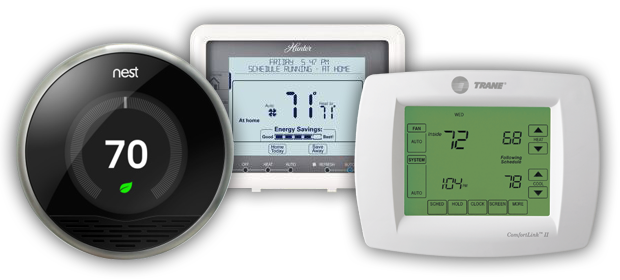There are two basic ways to maximize your heating and cooling energy efficiency. Either, by updating your old thermostat manually throughout the day, or by investing in a programmable thermostat.
According to Energy Star, the average household spends more than $2,000 a year on energy costs, up to half of which is for heating and cooling. With a programmable thermostat, you can save around $180 per year, maybe more as energy costs go up!
Programmable thermostats automatically monitor and adjust the temperature for you by following the instructions you program into them. By doing so, they save energy thus save you money. For instance, if you program your thermostat back 10º to 15º for an eight hour period, you’ll save about 5% to 15% a year on your heating bill. That translates to 1% savings for each degree you lower the setting over an eight hour period. During winter months, it’s recommended you set your thermostat to 68ºF while you’re at home and awake, and lowering it when you’re asleep or away.
Many qualified models also come with additional features, such as:
- Digital, backlit displays
- Touch pad screen programming
- Voice and/or phone programming
- Hold/Vacation features
- Indicators which tell you when it’s time to change air filters
- Indicators that signal malfunctioning of heating/cooling systems
- Adaptive Recovery/ Smart Recovery features — control features that senses the amount of time it will take to reach the next set-point temperature, and reach desired temperatures by the set time
How Do You Choose the Right One for You?
According to Energy Star, in order to decide which model is best for you, think about your schedule and how often you are away from home for regular periods of time — work, school, other activities — and then decide which of the three different models best fits your schedule: the 7-day, 5+2-day, or the 5-1-1-day.
7-day models are best if your daily schedule tends to change, say, if children are at home earlier on some days. They give you the most flexibility, and let you set different programs for different days — usually with four possible temperature periods per day.
5+2-day models use the same schedule every weekday, and another for weekends.
5-1-1 models are best if you tend to keep one schedule Monday through Friday and another schedule on Saturdays and Sundays.
A few misconceptions:
First, it’s not true that by setting the temperature back, and later setting it forward to the original temperature, you’re making your furnace work harder and actually consuming more energy. Worst case, you’ll most likely break-even as it uses just as much extra energy to reheat a room to its original temperature as the energy saved by reducing the heat. The longer you keep the temperature lowered, the more energy and cost savings you incur.
The second misconception is that you can reheat a room faster and more efficiently if you turn the thermostat to a higher than desired setting. No matter how high you turn up the thermostat’s temperature, the room will warm up at the same rate of speed. So, when you program your thermostat to reheat (or re-cool) your home or office, set it to the desired end temperature and no more or no less. Ask our professionals at Hobson if the new unit is compatible with your current unit’s wiring. Does the unit’s clock draw power from the heating system? Is the clock disrupted when the furnace cycles off? Is the thermostat precise enough for your needs? Is it too complicated (particularly digital models)?
Top smart programmable thermostats rated by CNET.com:
See a full list of programmable thermostats from Consumer Reports
The installation of your new thermostat and getting the most out of your new investment is where we can help. Call Hobson today at 630-761-3400 or fill out the form on the contact page to get a quote or schedule an appointment.

